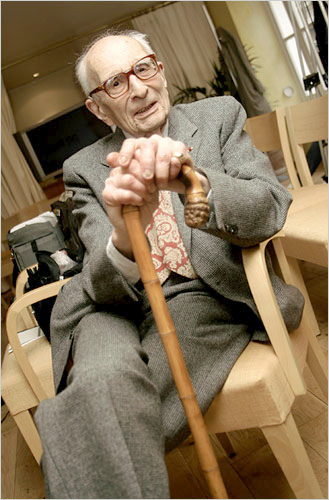The Internet is now full of the news that Lévi-Strauss has passed away, including an obituary at the New York Times and a collection of links at the AAA blog. Our blog — whose name is inspired by Lévi-Strauss — has discussed him in the past including some thoughts about his legacy on his 100th birthday. Many people have already shared their memories of him but what are we who never met him supposed to remember of his legacy? Perhaps it is time to be overly schematic and pare down the paeans to something more manageable for those who may be reading the news but find much of the veneration impenetrable. What, specifically, has Lévi-Strauss taught us? These are, to me, the things to take away from Lévi-Strauss’s writings:
First, Lévi-Strauss taught us that culture is a force in its own right. The idea that arbitrary and conventional systems of meaning are sui generis and have a determining force on our lives is one that is continually under assaults from various forms of reductionism. And yet Lévi-Strauss demonstrated forcefully and for all to see that the embarrassment of cultural riches found at our fingertips cannot be explained away as a result of protein or rational choice theory. Of course, we now have a much stronger understanding of how cultures work in practice than Lévi-Strauss had. But at a time when his work was interpreted at ‘intellectualist’ and people thought the etiolated visions of second-stringers like Marvin Harris were the ‘future of anthropology’, Lévi-Strauss demonstrated that it was impossible to ignore the power of culture.
Second, Lévi-Strauss taught us connoisseurship of culture. He treated cultures like works of art, and was in many sense the first person to analyze them — really analyze them — with the care that they deserved. Even today, when concrete analysis of culture has fallen by the wayside in the name of ‘theory’, Lévi-Strauss remains the great exemplar of how anthropologists work with cultural materials. The sources of his connoisseurship are varied — art appreciation, a French belle lettristic tradition, Boasian particularism — but there is no doubt that he was more or less single-handedly responsible for creating a mode of anthropological analysis that, while not universally practiced in our discipline, served both to create a distinct anthropological voice while demonstrating our utility and accessibility to other disciplines. Simply put, Lévi-Strauss taught us how to work with ethnographic materials.
More than that, Lévi-Strauss taught us to see anthropology as a work of art. He taught us that there was nothing wrong with writing beautifully — that in fact good analysis was itself beautiful, that its power to disclose new imaginative horizons was the result of its rhetorical power. Not everyone thinks this was a good idea — some see Lévi-Strauss as a harbinger of unobjective postmodernism, while others just bemoan the poor quality of the tremendous about of derivative work that followed in his wake. Whatever your stance on his position, no one can disagree that he showed us what a rigorous, humanistic anthropology looked like.
Finally, Lévi-Strauss got the relationship between the general and the particular right. He taught us to see the universal in small details. Boasian in his obsession with details, he also lifted us up to the highest and most abstract levels of thought, using little more than the detail on a piece of lace or the curve on the edge of a mask. Anthropology has always been haunted by its fierce commitment to the particular even as it strikes out towards general accounts of human society. Lévi-Strauss somehow knitted together ethnographic minutiae, comparative scope, and transcendent theorizing. This isn’t really an act that the rest of us can follow, but it was a vision that inspired others, and continues to set the tone as future generations of anthropologists try to imagine their own futures.
Of course — and I think this needs to be said despite the fact that this is a time for reverence — there was a lot wrong with Lévi-Strauss. While some pieces on the web hail mythologiques as his masterpiece, for many people it was a disappointment. The man is handed the world on a platter and the piece he produces to lead us on was… this? Its power was undeniable, and his positions much more complex than characterizations of his thought often presume (Marcel Henaff’s book Claude Lévi-Strauss and the Making of Structural Anthropology is the best (and extremely sympathetic) overview of his work). But still — there are points in the final chapters of Tristes Tropiques where I feel like my soul is being twisted by some titanic power to agree with a vision of the world that I find not just wrong but disturbing. His attempts to fit history and agency into his theoretical framework in his Introduction To The Work of Marcel Mauss always seemed painful and awkward to me. Nevertheless, the headlines are right — with Lévi-Strauss’s passing the world is watching one of its greatest intellectual move on. Will this spark a spate of fevered rereadings of Way of the Masks? Probably not — and we are probably worse off for it. And so now at the time of his passing we should celebrate him as he takes his leave from us to attain what is well and truly his regard éloignée.
